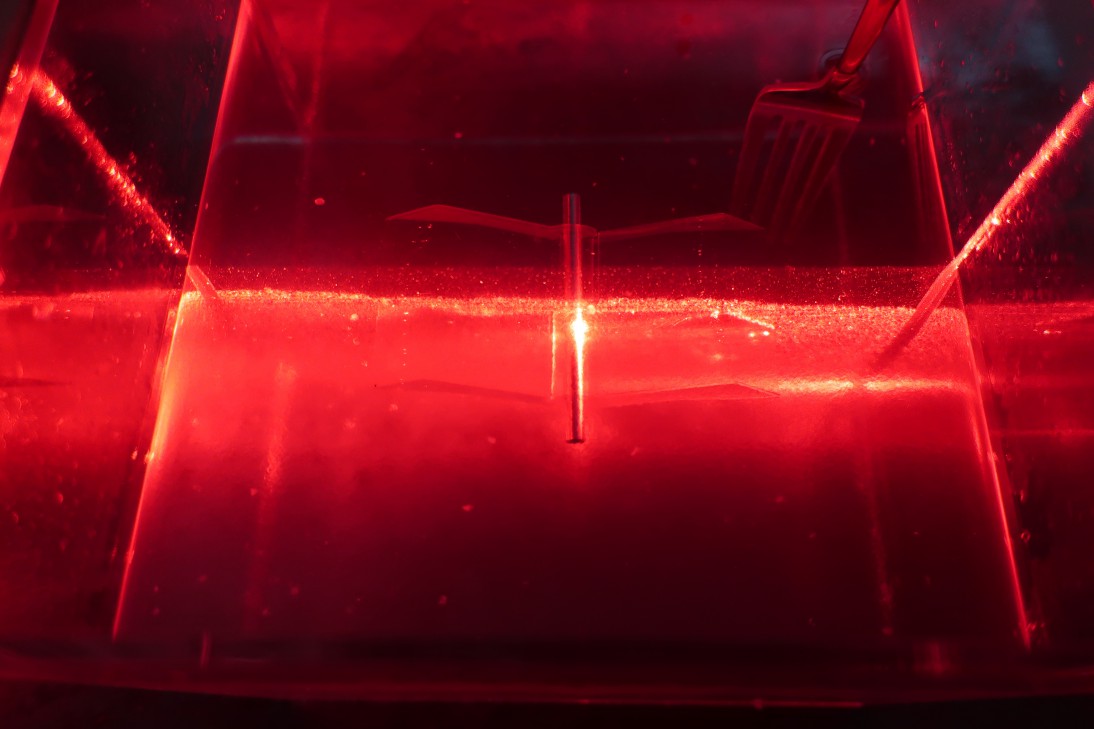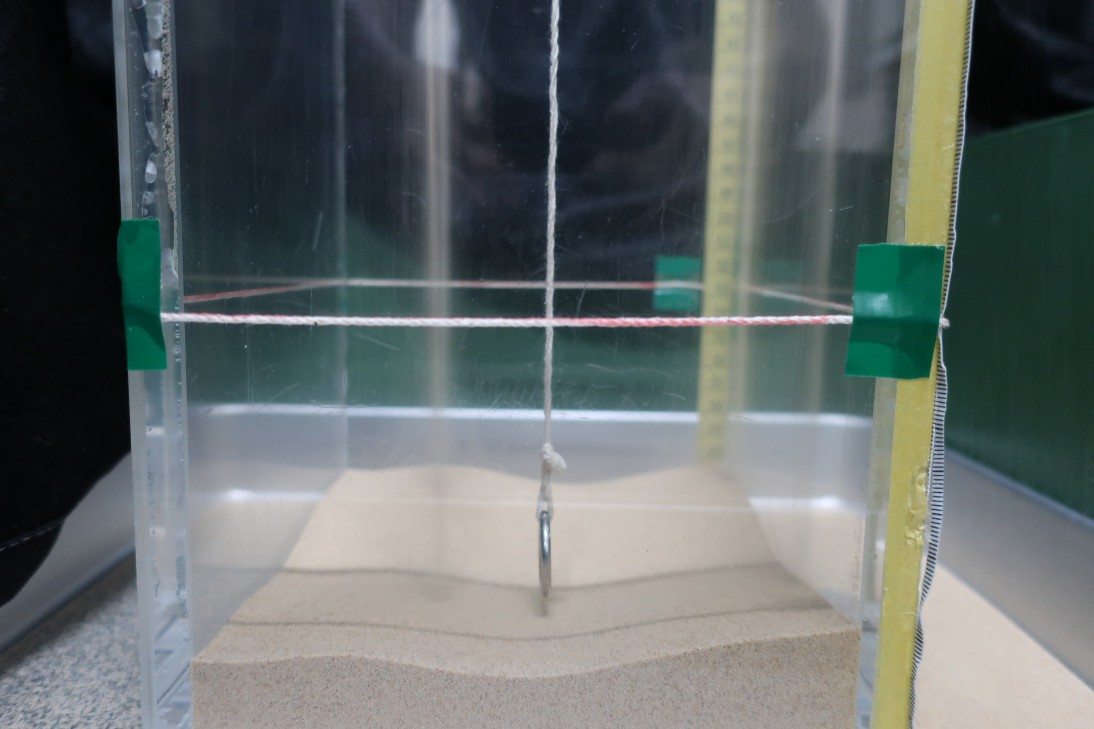RESEARCH
洋上風力発電 Offshore wind power
着床式と浮体式の両方の洋上風力発電を研究対象としており,着床式に関しては風車全体系の安定性や振動特性の解明,浮体式に関しては係留アンカーの地盤内での基本的な挙動や,新形式のアンカーの開発,浮体構造物~アンカーの相互作用などを研究しています。洋上風車は海底地盤に支持されたり,アンカーで繋がれています。風や波,地震などで風車は動揺しますが,その挙動は地盤の特性に大きく影響を受けます。地盤工学の観点から風車の動きを研究し,実際の設計に活かすことを目指しています。
We conduct research on both fixed-bottom and floating offshore wind turbines. For fixed-bottom systems, our focus is on elucidating the overall structural stability and vibration characteristics of the wind turbine. For floating systems, we investigate the fundamental behavior of mooring anchors within the seabed, develop novel anchor types, and analyze the interaction between floating structures and anchors. Offshore wind turbines are either supported directly by the seabed or tethered via anchors. Their dynamic response to wind, waves, and seismic events is strongly influenced by the properties of the underlying ground. Our goal is to study turbine behavior from a geotechnical perspective and apply these insights to practical design.
海底鉱物資源 Seafloor mineral resources
海底には多くの鉱物資源が眠っています。水深数千メートルの海底で,どのように鉱物を採取し,それを船上まで揚げ,資源採取後の土をどのように環境に配慮して海底で処分するかを研究しています。採取に関しては軟弱な地盤上での鉱物の採取方法を検討し,海底から船上まで揚鉱する方法としては流動化した土を利用する技術を開発中です。資源を採取した残土の適切な処理方法,海底へ戻す手法なども検討しています。海底資源の活用の実現可能性を高めるため,地盤工学分野から海底鉱物資源採掘の一連のサイクルを総合的に研究しています。
A vast array of mineral resources lies dormant beneath the seafloor. Our research focuses on how to extract these minerals from depths of several thousand meters, transport them to the surface, and responsibly manage the post-extraction sediments with environmental considerations in mind. For the extraction process, we are exploring methods suitable for recovering minerals from soft seabed conditions. To lift the extracted materials from the seafloor to the vessel, we are developing technologies that utilize fluidized sediment transport. We also investigate appropriate treatment and disposal methods for the residual soil after resource recovery, including techniques for returning it to the seabed in an environmentally sound manner. To enhance the feasibility of seafloor resource utilization, we conduct comprehensive studies on the entire cycle of deep-sea mineral extraction from the perspective of geotechnical engineering.
海底地盤調査 Seafloor geotechnical survey
洋上風力発電施設などの構造物を海洋に建設する場合,まずは海底地盤の状況を調査します。この調査結果に基づいて構造物が設計・施工されます。調査では,非接触の物理探査に続いて,貫入試験などによって原位置で地盤情報を得て,一部の土を採取して室内試験を行います。この調査の過程で,海底地盤においていかに効率的かつ経済的に原位置調査を行うかという研究に取り組んでいます。例えば,コーン貫入試験とサンプリングを同時に行う方法(Sampling and CPT)の開発や,海底地盤の表層数メートルを効率的に調査できる新しいコーン貫入試験の開発などを行っています。
When constructing offshore structures such as wind power generation facilities, it is essential to begin by investigating the seabed. Based on the results of this investigation, the structures are then designed and built. The survey process typically starts with non-contact geophysical exploration, followed by in-situ testing methods such as cone penetration tests to obtain detailed ground information. Soil samples are also collected for laboratory testing. Through this process, we are conducting research on how to perform in-situ seabed investigations more efficiently and economically. For example, we are developing techniques that combine cone penetration testing and sampling simultaneously (Sampling and CPT), as well as new cone penetration methods that enable efficient investigation of the upper few meters of the seabed.
沿岸構造物 Coastal engineering structure
沿岸域には,波から陸域を守りつつ,海を利活用するための防波堤や岸壁,護岸,堤防などの沿岸構造物が設置されています。これらの高波や津波、地震動などの大きな外力作用下での挙動について研究しています。高波や津波で防波堤が被災することが続いていますが,砕石地盤を効率的に配置して防波堤を補強する方法を検討したり,巨大地震に岸壁がどのように挙動するか,また,被災しないようにどのように補強するかなどを研究しています。さらに,沿岸域は流体~地盤の相互作用が発生する場所であり,波による護岸の被災メカニズムなどを地盤工学の立場から研究しています。さらに,各種地盤改良工法についても研究を行っています。
Coastal areas are equipped with various structures—such as breakwaters, quaywalls,seawalls, and embankments—to protect inland regions from wave action while enabling the effective use of marine spaces. Our research focuses on the behavior of these coastal structures under extreme external forces, including high waves, tsunamis, and seismic ground motions. Given the recurring damage to breakwaters caused by storm waves and tsunamis, we are investigating methods to reinforce these structures by strategically placing rubble mound foundations. We also study how quay walls respond to large-scale earthquakes and explore reinforcement techniques to prevent structural failure. Furthermore, coastal zones are sites of complex fluid–soil interactions. From a geotechnical engineering perspective, we analyze the failure mechanisms of revetments due to wave action and aim to improve the resilience of coastal infrastructure. In addition, our research covers a range of ground improvement methods.











